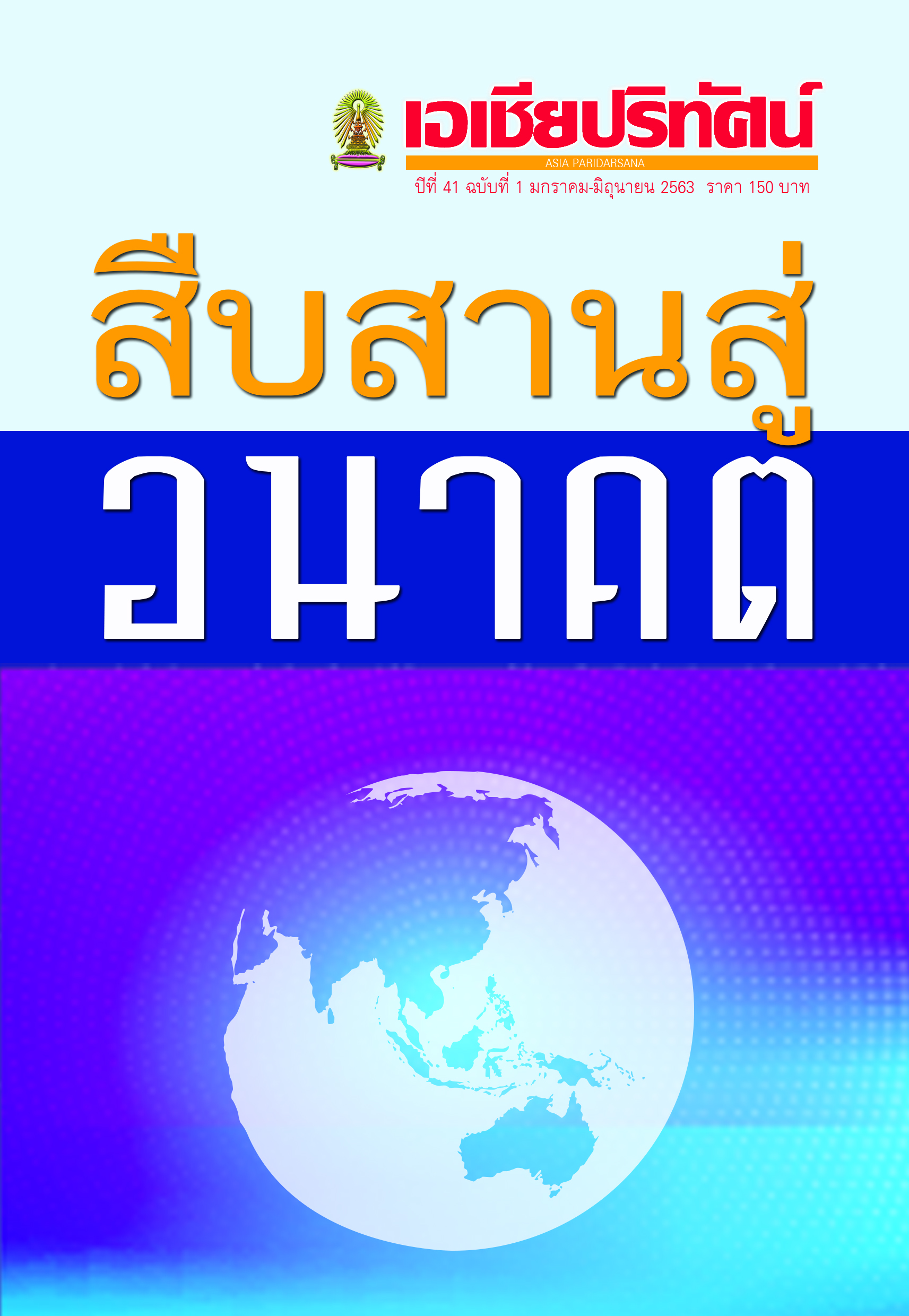ปัจจัยแห่งความสำเร็จต่อภูมิปัญญาการทำขนมผูกรักเพื่อเชื่อมความสัมพันธ์ของคนในชุมชนพหุวัฒนธรรมบ้านเจ๊ะบิลัง จังหวัดสตูล
Main Article Content
บทคัดย่อ
งานวิจัยนี้มีวัตถุประสงค์เพื่อวิเคราะห์ปัจจัยแห่งความสำเร็จ ผ่านมุมมองของภูมิปัญญาการทำขนมผูกรักในการเชื่อมความสัมพันธ์ของชุมชนพหุวัฒนธรรมในพื้นที่จังหวัดสตูล ตามแนวคิดการจัดการภูมิปัญญาท้องถิ่นที่ส่งผลเชิงบวกในเชิงเศรษฐกิจจากการนำภูมิปัญญามาประยุกต์ใช้ในปัจจุบัน โดยใช้เทคนิคการวิจัยเชิงปริมาณ จากกลุ่มตัวอย่าง 390 คน และวิเคราะห์ข้อมูลโดยใช้การวิเคราะห์ถดถอยแบบพหุคูณ (Multiple Regression Analysis) ผลการศึกษา พบว่า ปัจจัยที่มีอิทธิพลต่อความสำเร็จ มี 5 ปัจจัย ได้แก่ (1) การเล็งเห็นคุณค่าทางประวัติศาสตร์ของภูมิปัญญาท้องถิ่น (2) การสร้างสรรค์ภูมิปัญญาท้องถิ่นให้เกิดการพัฒนาจากคนในชุมชน (3) การส่งเสริมการสร้างนวัตกรรมผ่านภูมิปัญญาท้องถิ่นขนมผูกรักในเชิงเศรษฐกิจ (4) การสนับสนุนจากหน่วยงานที่เกี่ยวข้อง และ (5) ส่งเสริมและพัฒนาต่อยอดภูมิปัญญาการนำขนมผูกรักไปสู่ระดับนานาชาติ
ทั้งนี้เพื่อให้ภูมิปัญญาท้องถิ่นการทำขนมผูกรักสามารถเกิดการอนุรักษ์ สืบทอด ต่อยอด และเกิดคุณค่าเชิงเศรษฐกิจได้ จำเป็นต้องสร้างการมีส่วนร่วมให้กับกลุ่มเยาวชนในชุมชน เกิดความตระหนักและเล็งเห็นคุณค่า มีความพร้อมด้านทรัพยากร ความริเริ่มสร้างสรรค์ เพื่อพัฒนาองค์ความรู้ด้านภูมิปัญญาให้เกิดการสร้างอาชีพและรายได้ที่มั่นคง และยังเป็นการสร้างความสัมพันธ์อันดีระหว่างคนในชุมชน ทั้งความรักใคร่ ความสามัคคี และเกิดความไว้ใจท่ามกลางความหลากหลายอย่างลงตัว
Article Details
เอกสารอ้างอิง
กรมวิชาการ. 2539. รายงานการวิจัย เรื่อง ภูมิปัญญาท้องถิ่นกับการจัดการเรียนการสอนในระดับประถมศึกษาและมัธยมศึกษา. กรุงเทพมหานคร: โรงพิมพ์คุรุสภา.
กรมส่งเสริมการเกษตร. 2552. ความรู้เบื้องต้นเกี่ยวกับภูมิปัญญาท้องถิ่น. กรุงเทพมหานคร: กรมส่งเสริมการเกษตร.
กรมส่งเสริมวัฒนธรรม. 2558. วัฒนธรรม วิถีชีวิต และภูมิปัญญา. พิมพ์ครั้งที่ 1. กรุงเทพมหานคร: บริษัท รุ่งศิลป์การพิมพ์ (๑๙๗๗) จำกัด.
กระทรวงการอุดมศึกษา วิทยาศาสตร์ วิจัยและนวัตกรรม. 2562. กระทรวงการอุดมศึกษา วิทยาศาสตร์ วิจัย และนวัตกรรม ขานรับไทยแลนด์ 4.0 ผนึกกำลัง 2 หน่วยงานใหญ่ สถาบันพัฒนาอุตสาหกรรมสิ่งทอ และสถาบันอาหาร ส่ง “โครงการพัฒนานวัตกรรมผลิตภัณฑ์ชุมชนำสำหรับผู้ประกอบการรุ่นใหม่ (IGNITE PLUS)” ยกระดับผู้ประกอบการ OTOP, เข้าถึงเมื่อ 5 ตุลาคม 2562. https://www.thaitextile.org/th/activities/detail.1236.1.0.html.
ชลทิตย์ เอี่ยมสำอาง และ วิศนี ศิลตระกูล. 2533. ภูมิปัญญาชาวบ้าน เทคโนโลยีพื้นบ้าน และแหล่งวิทยาการชุมชน. เอกสารการสอนชุดวิชาการพัฒนาและการใช้แหล่งวิทยาการในชุมชน. นนทบุรี: มหาวิทยาลัยสุโขทัยธรรมาธิราช.เอเชียปริทัศน์ ปีที่ 41 ฉบับที่ 1 มกราคม - มิถุนายน 2563 107
ซัยนับ มะสมัน. 2558. อิทธิพลของวัฒนธรรมอาหรับต่อสังคมมุสลิมในเขตอำเภอเมือง จังหวัดสตูล, เข้าถึงเมื่อ 18ตุลาคม 2562. http://kb.psu.ac.th/psukb/handle/2016/11088.
ประเวศ วะสี. 2534. การสร้างสรรค์ภูมิปัญญาไทยเพื่อการพัฒนา. ใน สำนักงานคณะกรรมการวัฒนธรรมแห่งชาติ. การสัมมนาทางวิชาการเรื่องภูมิปัญญาชาวบ้าน, 78 – 87. กรุงเทพฯ: คุรุสภาลาดพร้าว.
ปราณี ตันตยานุบุตร. 2550. ภูมิปัญญาไทย. กรุงเทพฯ: มหาวิทยาลัยธุรกิจบัณฑิตย์.
รัชฎาพร เกตานนท์ แนวแห่งธรรม. 2560. “แนวทางการพัฒนาผลิตภัณฑ์ภูมิปัญญาท้องถิ่นเพื่อส่งเสริมเศรษฐกิจสร้างสรรค์ในจังหวัดนครปฐม.” วารสาร Veridian E-Journal, Silpakorn University (Humanities, Social Sciences and arts) 10 (1): 994-1013.
ลัดดาวัลย์ สำราญ. 2559. “ปัจจัยที่ส่งผลต่อความเข้มแข็งของชุมชน กรณีศึกษา อำเภอสามชุก จังหวัดสุพรรณบุรี.” ในการประชุมวิชาการระดับชาติ มหาวิทยาลัยเทคโนโลยีราชมงคลสุวรรณภูมิ ครั้งที่ 1 (The 1st RUSNC), 22 มิถุนายน 2559
เลิศชาย ศิริชัย. (บรรณาธิการ). 2547. ภูมิปัญญาท้องถิ่น: จากข้อเท็จจริงยกระดับสู่กระบวนทัศน์ความเข้มแข็งชุมชน. นครศรีธรรมราช: เม็ดทราย.
วชิรวัชร งามละม่อม. 2558. แนวคิดเรื่องภูมิปัญญาท้องถิ่น (Local Wisdom Ap¬proach), เข้าถึงเมื่อ 5 ตุลาคม 2562 http://learningofpublic.blogspot.com/2015/09/local-wisdom-approach.html.108 เอเชียปริทัศน์ ปีที่ 41 ฉบับที่ 1 มกราคม - มิถุนายน 2563
สมบูรณ์ ธรรมลังกา. 2556. “รูปแบบการเสริมสร้างความเข้มแข็งของชุมชนโดยใช้ภูมิปัญญาท้องถิ่นเป็นฐานในจังหวัดเชียงราย.” วารสารศึกษาศาสตร์ มหาวิทยาลัยนเรศวร 15(2): 58-66.
สายชล ปัญญชิต และพฤทธิ์ ศุภเศรษฐศิริ. 2562. “ภูมิปัญญากับการพัฒนา: บทวิเคราะห์ว่าด้วยการบวชป่าเพื่อการพัฒนาอย่างยั่งยืน.” มจร สังคมศาสตร์ปริทรรศน์ 8(1): 253 – 263.
สำนักงานจังหวัดสตูล. 2012. ประวัติจังหวัดสตูล, เข้าถึงเมื่อ 16 ตุลาคม 2562. http://www.satun.go.th/91000/index.php/satun-profile/history-of-the-province
สำนักงานสถิติแห่งชาติ. 2553. จำนวนประชากรและบ้าน จำแนกเป็นรายอำเภอ และรายตำบล จังหวัดสตูล, เข้าถึงเมื่อ 17 ตุลาคม 2562. http://service.nso.go.th/nso/nsopublish/districtList/S010107/th/75.htm.
เอกวิทย์ ณ ถลาง. 2540. ภูมิปัญญาชาวบ้าน 4 ภูมิภาค: วิถีชีวิตและกระบวนการเรียนรู้ของชาวบ้านไทย. นนทบุรี: มหาวิทยาลัยสุโขทัยธรรมาธิราช.
เอกสารประกอบการประชุมประจำปี การพัฒนาที่ยั่งยืน. (30 มิถุนายน 2546). เอกสารอัดสำเนา.
Drost, E. 2011. “Validity and Reliability in Social Science Research.” Edu¬cation Research and Perpectives 38(1): 105-123.
UCLA Institute for Digital Research and Education. 2019. Regression with SPSS Chapter 1 – Simple and Multiple Regression, Accessed September 20, 2019. https://Stats.idre.ucla.edu/.


